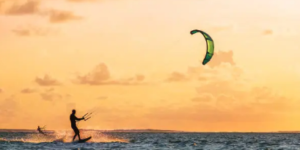Foil boarding is an exhilarating water sport that challenges the limits of traditional surfing and opens up a world of possibilities. With a few essential tips and beginner-friendly techniques, you can be well on your way to foiling in no time!
A foil board consists of a main wing for lift and a mast that provides stability. You stand atop the foil and transfer your energy into forward momentum by shifting your weight left and right. For more information about the AssaultBoarding foiling, click here.
Beginner’s Guide
 Foiling offers the ultimate thrill and is an entirely different experience from riding a twin tip. It takes a lot of time, practice and patience to master the basic skills.
Foiling offers the ultimate thrill and is an entirely different experience from riding a twin tip. It takes a lot of time, practice and patience to master the basic skills.
The first step is to have the right equipment for your weight and wind conditions. A small light board with a volume only slightly over your weight is the best choice to start learning. Use a foil with rugged handles to get more grip and reduce the risk of slipping out. A short mast is ideal for beginners, preventing the foil from breaking the water’s surface when you fall off.
The front wing size and plan shape determine the performance of your foil and what discipline you will ride it for. As a general rule of thumb, a larger front wing generates more lift at lower speeds.
Safety Tips
Foil boards have sharp wing tips that could cause injury, so wearing a helmet such as this AK Durable Supply Co Riot Helmet is essential. A personal flotation device (PFD) is also recommended, especially during a learning phase.
If you fall off your foil, it’s essential to hang onto the wing as much as possible to keep from cutting yourself on something sharp and to prevent the board from travelling too far in an uncontrolled way.
Foiling is much easier if you have watersports experience, such as surfing, prone or stand-up, windsurfing, kiteboarding, etc. It’s also best to start in flat water with minimal boat traffic and obstacles, with a short mast and progress to a longer one as your skills develop.
Equipment
Foiling is more complex than regular surfing but can be mastered by anyone who has the desire. Foiling requires a personal flotation device (PFD), a helmet, and appropriate clothing for the conditions. Watersport experience such as prone surf, sup, kite surf, windsurfing or water skiing is helpful to learn the fundamentals of Foiling.
Equipment needed for Foiling includes a specialized board, foil wings and mast assembly, which transfers energy from the rider to the foil. Foot straps and a wetsuit are also helpful to keep the rider comfortable as they learn the basics of Foiling.
The Assault Boarding, ASSAULT Upgrade Set, is a detailed resin conversion kit for the Space Marine boarding squadrons. The kit contains two last cutters, a graviton gun and enough weapon arms, boarding shields and heads to build five Space Marine boarding assault specialists.
Where to Foil
The learning curve for Foiling is a lot quicker if you have prior watersport experience. Surfing prone or stand-up paddle surfing, windsurfing, kiteboarding or water skiing are all good starts. For more information about the AssaultBoarding foiling, click here.
A dedicated foil surfboard with a track is essential to help you get up on the foil and keep your balance in flight. Most local shapers are beginning to offer dedicated foil boards or retrofitting their existing board models.
Start with small crumbly waves that are not crowded and practice the on-foil process, catching whitewater and increasing pressure on your back foot until you feel the board lift. Keeping weight forward will bring the nose back down.
Always wear a personal flotation device and a helmet. Foiling is dangerous and can cause injury to others. Stay away from crowded surf conditions and keep a safe distance from other foilers, as they can easily hit you with their foil. A leash is also a great idea to prevent your foil from getting away from you in case of a fall.
